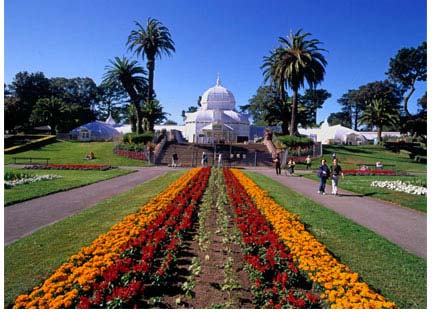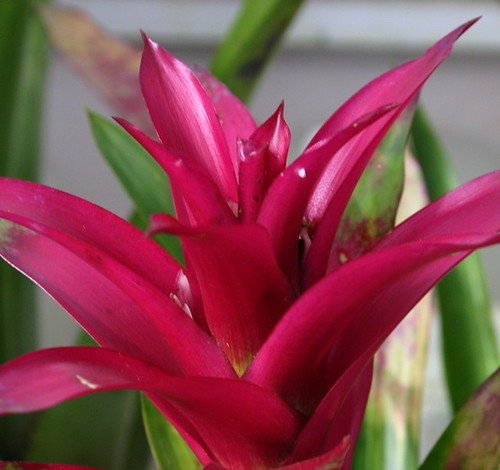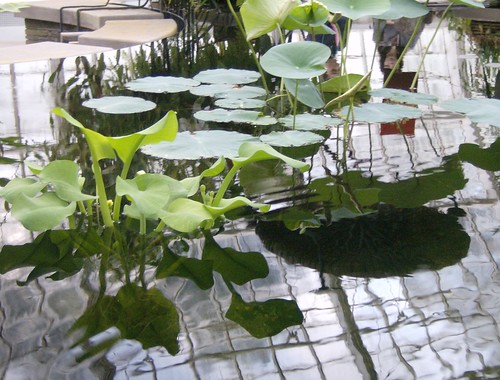The Conservatory of Flowers is a large botanical greenhouse in San Francisco's Golden Gate Park, constructed in 1878. It houses an important collection of exotic plants. It is the oldest building in Golden Gate Park and the oldest municipal wooden conservatory remaining in the United States. It is also one of the first municipal conservatories constructed in the country. For these distinctions and for its associated historical, architectural, and engineering merits, the Conservatory of Flowers is listed on the National Register of Historic Places, the California Register of Historic Places, is a San Francisco Landmark, and is a Historic Civil Engineering Landmark of the American Society of Civil Engineers.

Architectural Description The Conservatory of Flowers is an elaborate Victorian greenhouse with a central dome rising nearly 60 feet (18 m) high and arch-shaped wings extending from it for an overall length of 240 feet (73 m). It sits atop a gentle slope overlooking Conservatory Valley. The structural members are articulated through one predominant form, a four-centered or Tudor arch. The Conservatory of Flowers consists of a wood structural skeleton with glass walls set on a raised masonry foundation. The entire structure has a shallow E-shaped plan that is oriented along an east-west axis. The central 60-foot (18 m) high pavilion is entered through a one-story, glassed-in vestibule with a gable roof on the south side of the pavilion. Flanking the rotunda to the east and west are one-story, symmetrical wings framed by wood arches. Each wing is L-shaped in plan, with cupolas adorning the intersection of the two segments. The octagonal pavilion supports an arched roof that is, in turn, surmounted by a clerestory and dome. The clerestory is supported by eight, free-standing, wood-clad, cast iron columns located within the rotunda and grouped in pairs.  Projecting from the pavilion roof on the east, west, and south elevations are dormer windows with peak roofs. Between major arched structural framing members are wood muntins that hold the glass lights on their sides. The lights are lapped one over one another like shingles and follow the curve of the arches. The construction of each arch is aesthetically appealing in its simplicity, but also structurally clever in that it takes maximum advantage of wood as a building material while overcoming its inherent structural shortcomings. From a structural perspective, the arch design utilizes the mechanical properties of the material. Wood is strongest along the length of the grain and weakest along the end grain. The use of short arch components with shallow radii minimized the amount of weaker end grain exposed to structural forces. The assembly of the arch with several small pieces of wood, the shapes of which are identical from arch to arch, is efficient. It allowed the fabricator to set the machines with guides and templates so that cutting the multiple-arch components was a simple task. Furthermore, the design required little material since each individual arch component has only a shallow radius. Moreover, by using relatively narrow widths of lumber, the chance of warping was minimized. Finally, there was an efficiency realized in transportation, as the small size of the arch components allowed them to be easily stored and shipped. The structural wood arches and their method of construction, along with the decorative woodwork and unique lapped glazing, define the character of the Conservatory of Flowers. The major character-defining elements associated with the Conservatory of Flowers consist of ornamental and structural woodwork, including the method of fabrication used for the arches, the lapped glazing system, the ventilation system, and the building’s siting and exterior landscaping.
Projecting from the pavilion roof on the east, west, and south elevations are dormer windows with peak roofs. Between major arched structural framing members are wood muntins that hold the glass lights on their sides. The lights are lapped one over one another like shingles and follow the curve of the arches. The construction of each arch is aesthetically appealing in its simplicity, but also structurally clever in that it takes maximum advantage of wood as a building material while overcoming its inherent structural shortcomings. From a structural perspective, the arch design utilizes the mechanical properties of the material. Wood is strongest along the length of the grain and weakest along the end grain. The use of short arch components with shallow radii minimized the amount of weaker end grain exposed to structural forces. The assembly of the arch with several small pieces of wood, the shapes of which are identical from arch to arch, is efficient. It allowed the fabricator to set the machines with guides and templates so that cutting the multiple-arch components was a simple task. Furthermore, the design required little material since each individual arch component has only a shallow radius. Moreover, by using relatively narrow widths of lumber, the chance of warping was minimized. Finally, there was an efficiency realized in transportation, as the small size of the arch components allowed them to be easily stored and shipped. The structural wood arches and their method of construction, along with the decorative woodwork and unique lapped glazing, define the character of the Conservatory of Flowers. The major character-defining elements associated with the Conservatory of Flowers consist of ornamental and structural woodwork, including the method of fabrication used for the arches, the lapped glazing system, the ventilation system, and the building’s siting and exterior landscaping. 
 Projecting from the pavilion roof on the east, west, and south elevations are dormer windows with peak roofs. Between major arched structural framing members are wood muntins that hold the glass lights on their sides. The lights are lapped one over one another like shingles and follow the curve of the arches. The construction of each arch is aesthetically appealing in its simplicity, but also structurally clever in that it takes maximum advantage of wood as a building material while overcoming its inherent structural shortcomings. From a structural perspective, the arch design utilizes the mechanical properties of the material. Wood is strongest along the length of the grain and weakest along the end grain. The use of short arch components with shallow radii minimized the amount of weaker end grain exposed to structural forces. The assembly of the arch with several small pieces of wood, the shapes of which are identical from arch to arch, is efficient. It allowed the fabricator to set the machines with guides and templates so that cutting the multiple-arch components was a simple task. Furthermore, the design required little material since each individual arch component has only a shallow radius. Moreover, by using relatively narrow widths of lumber, the chance of warping was minimized. Finally, there was an efficiency realized in transportation, as the small size of the arch components allowed them to be easily stored and shipped. The structural wood arches and their method of construction, along with the decorative woodwork and unique lapped glazing, define the character of the Conservatory of Flowers. The major character-defining elements associated with the Conservatory of Flowers consist of ornamental and structural woodwork, including the method of fabrication used for the arches, the lapped glazing system, the ventilation system, and the building’s siting and exterior landscaping.
Projecting from the pavilion roof on the east, west, and south elevations are dormer windows with peak roofs. Between major arched structural framing members are wood muntins that hold the glass lights on their sides. The lights are lapped one over one another like shingles and follow the curve of the arches. The construction of each arch is aesthetically appealing in its simplicity, but also structurally clever in that it takes maximum advantage of wood as a building material while overcoming its inherent structural shortcomings. From a structural perspective, the arch design utilizes the mechanical properties of the material. Wood is strongest along the length of the grain and weakest along the end grain. The use of short arch components with shallow radii minimized the amount of weaker end grain exposed to structural forces. The assembly of the arch with several small pieces of wood, the shapes of which are identical from arch to arch, is efficient. It allowed the fabricator to set the machines with guides and templates so that cutting the multiple-arch components was a simple task. Furthermore, the design required little material since each individual arch component has only a shallow radius. Moreover, by using relatively narrow widths of lumber, the chance of warping was minimized. Finally, there was an efficiency realized in transportation, as the small size of the arch components allowed them to be easily stored and shipped. The structural wood arches and their method of construction, along with the decorative woodwork and unique lapped glazing, define the character of the Conservatory of Flowers. The major character-defining elements associated with the Conservatory of Flowers consist of ornamental and structural woodwork, including the method of fabrication used for the arches, the lapped glazing system, the ventilation system, and the building’s siting and exterior landscaping. 
The material for the conservatory was purchased by James Lick prior to his death in 1876. Lick died before constructing the conservatory on his estate, and it was put up for sale by his trustees. The material was then purchased by a group of prominent San Franciscans who offered it to the City of San Francisco for use in Golden Gate Park.  The Parks Commission accepted the gift and hired Lord & Burnham, a greenhouse manufacturing company from New York, to supervise the erection of the structure. Once open, it contained a large variety of rare and tropical plants, including a giant water lily, Victoria Regia, which at the time was the only known specimen in the United States. Historic Context In both Europe and America, the nineteenth century brought increased urbanization and industrialization. In response, city governments began providing city-dwellers with open spaces and natural settings for public use. The profession of Landscape Architecture expanded during the later part of the nineteenth century, and park design became a large part of this new profession’s repertoire. In addition, a significant outgrowth of the need for natural surroundings in urban contexts was an increase in the study of plant sciences during this period, both by professionals and amateurs. A building type called the glasshouse or conservatory took shape in which the city-dweller could view masterpieces of the plant world otherwise unavailable in urban environments. Municipalities and individuals spent a great deal of time and money to construct these building types that became known as “theaters of nature.” Similar conservatories were constructed across Europe, starting in the early 1800s. Perhaps the most well known of these is the Palm Stove House in the Kew Royal Gardens in London. These structures were enjoyed by a broad cross-section of the public. Following European fashions, wealthy Americans began to construct conservatories in the mid-1800s on private estates. James Lick, a wealthy Californian, purchased a conservatory for his Santa Clara Valley estate but died before it could be erected.
The Parks Commission accepted the gift and hired Lord & Burnham, a greenhouse manufacturing company from New York, to supervise the erection of the structure. Once open, it contained a large variety of rare and tropical plants, including a giant water lily, Victoria Regia, which at the time was the only known specimen in the United States. Historic Context In both Europe and America, the nineteenth century brought increased urbanization and industrialization. In response, city governments began providing city-dwellers with open spaces and natural settings for public use. The profession of Landscape Architecture expanded during the later part of the nineteenth century, and park design became a large part of this new profession’s repertoire. In addition, a significant outgrowth of the need for natural surroundings in urban contexts was an increase in the study of plant sciences during this period, both by professionals and amateurs. A building type called the glasshouse or conservatory took shape in which the city-dweller could view masterpieces of the plant world otherwise unavailable in urban environments. Municipalities and individuals spent a great deal of time and money to construct these building types that became known as “theaters of nature.” Similar conservatories were constructed across Europe, starting in the early 1800s. Perhaps the most well known of these is the Palm Stove House in the Kew Royal Gardens in London. These structures were enjoyed by a broad cross-section of the public. Following European fashions, wealthy Americans began to construct conservatories in the mid-1800s on private estates. James Lick, a wealthy Californian, purchased a conservatory for his Santa Clara Valley estate but died before it could be erected.
 The Parks Commission accepted the gift and hired Lord & Burnham, a greenhouse manufacturing company from New York, to supervise the erection of the structure. Once open, it contained a large variety of rare and tropical plants, including a giant water lily, Victoria Regia, which at the time was the only known specimen in the United States. Historic Context In both Europe and America, the nineteenth century brought increased urbanization and industrialization. In response, city governments began providing city-dwellers with open spaces and natural settings for public use. The profession of Landscape Architecture expanded during the later part of the nineteenth century, and park design became a large part of this new profession’s repertoire. In addition, a significant outgrowth of the need for natural surroundings in urban contexts was an increase in the study of plant sciences during this period, both by professionals and amateurs. A building type called the glasshouse or conservatory took shape in which the city-dweller could view masterpieces of the plant world otherwise unavailable in urban environments. Municipalities and individuals spent a great deal of time and money to construct these building types that became known as “theaters of nature.” Similar conservatories were constructed across Europe, starting in the early 1800s. Perhaps the most well known of these is the Palm Stove House in the Kew Royal Gardens in London. These structures were enjoyed by a broad cross-section of the public. Following European fashions, wealthy Americans began to construct conservatories in the mid-1800s on private estates. James Lick, a wealthy Californian, purchased a conservatory for his Santa Clara Valley estate but died before it could be erected.
The Parks Commission accepted the gift and hired Lord & Burnham, a greenhouse manufacturing company from New York, to supervise the erection of the structure. Once open, it contained a large variety of rare and tropical plants, including a giant water lily, Victoria Regia, which at the time was the only known specimen in the United States. Historic Context In both Europe and America, the nineteenth century brought increased urbanization and industrialization. In response, city governments began providing city-dwellers with open spaces and natural settings for public use. The profession of Landscape Architecture expanded during the later part of the nineteenth century, and park design became a large part of this new profession’s repertoire. In addition, a significant outgrowth of the need for natural surroundings in urban contexts was an increase in the study of plant sciences during this period, both by professionals and amateurs. A building type called the glasshouse or conservatory took shape in which the city-dweller could view masterpieces of the plant world otherwise unavailable in urban environments. Municipalities and individuals spent a great deal of time and money to construct these building types that became known as “theaters of nature.” Similar conservatories were constructed across Europe, starting in the early 1800s. Perhaps the most well known of these is the Palm Stove House in the Kew Royal Gardens in London. These structures were enjoyed by a broad cross-section of the public. Following European fashions, wealthy Americans began to construct conservatories in the mid-1800s on private estates. James Lick, a wealthy Californian, purchased a conservatory for his Santa Clara Valley estate but died before it could be erected.



from wikipedia.org
Images from flickr users: neefer, sftrajan, Yotowoti, amster girl, judywatt,

No comments:
Post a Comment